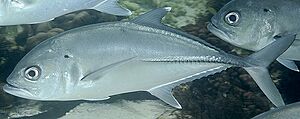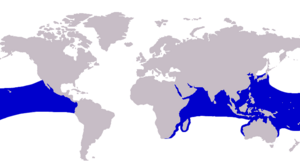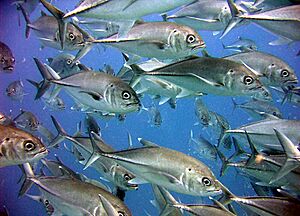Bigeye trevally facts for kids
Quick facts for kids Bigeye trevally |
|
|---|---|
 |
|
| Conservation status | |
| Scientific classification | |
 |
|
| Approximate range of the bigeye trevally | |
| Synonyms | |
|
The bigeye trevally (Caranx sexfasciatus) is a large marine fish. It is also known as the bigeye jack or six-banded trevally. This fish belongs to the jack family, called Carangidae.
You can find bigeye trevally in the warm, tropical waters of the Indian and Pacific Oceans. Their range stretches from South Africa to California and Ecuador. They also live near Australia and Japan. You can spot them by their dark second dorsal fin with a white tip. They also have a small dark spot on their gill cover. These fish can grow quite large, up to 120 cm long and weigh 18 kg.
Bigeye trevally mostly live near the reefs, up to 100 m deep. They can be found near coasts and offshore islands. Young fish often explore estuaries and sandy bays. During the day, they usually swim in large, slow-moving schools. At night, they become active hunters. They eat a variety of fish, crustaceans, and cephalopods. Young fish eat more crustaceans, while adults mostly eat other fish.
These fish reach sexual maturity when they are about 42 cm long. They gather in large groups to spawn at different times of the year. Bigeye trevally are important for fisheries in many areas. People catch them using gill nets, purse seines, and hooks. They are considered good to eat and are also popular for sport fishing.
Contents
About the Bigeye Trevally
The bigeye trevally is part of the Caranx group of fish. This group is known as jacks or trevallies. Caranx is a genus within the larger Carangidae family. This family includes jacks and horse mackerels. All these fish belong to the order Carangiformes.
How the Bigeye Trevally Got Its Name
Before 1825, people often confused this fish with a similar one from the Atlantic Ocean. French naturalists Jean René Constant Quoy and Joseph Paul Gaimard first described the bigeye trevally in 1825. They found a specimen near Waigeo, Indonesia. They named it Caranx sexfasciatus. The name sexfasciatus means 'six banded'. This refers to the dark bands seen on young fish.
Over time, the fish was described and named many more times. However, Caranx sexfasciatus is the name still used today. All other names are considered older, incorrect names. The most common name for this fish is 'bigeye trevally'. Other names include 'bigeye jack' and 'six-banded trevally'.
What Does a Bigeye Trevally Look Like?
The bigeye trevally is one of the bigger fish in the Caranx group. It can grow up to 120 cm long and weigh 18 kg. Like most jacks, it has a flat, oval-shaped body. Its back is a bit more curved than its belly. The snout is slightly pointed and longer than the eye.
Fins and Scales
The fish has two main dorsal fins. The first has 8 stiff spines. The second has 1 spine and 19 to 22 soft rays. The anal fin has 2 separate spines, then 1 spine and 14 to 17 soft rays. Its caudal fin is deeply forked, like a "V".
The lateral line on its side is curved at the front. It has 49 to 50 scales in this part. The straight part has 27 to 36 strong, bony scutes. The area under its head is fully covered in scales. The bigeye trevally also has large adipose eyelids. These are fatty eyelids that cover part of its eye.
Teeth and Gills
Its upper jaw has an outer row of widely spaced canine teeth. It also has an inner band of small, brush-like teeth. The lower jaw has a row of widely spaced cone-shaped teeth. This fish has 21 to 25 gill rakers, which help it filter food. It also has 25 vertebrae, or backbones.
Color Changes as They Grow
Bigeye trevally change color as they get older. Young fish are silvery-yellow to silvery-brown. They have five to six dark vertical bands on their sides. This is where the name sexfasciatus (six-banded) comes from.
As they grow, these bands fade away. Adults become silvery-blue on top and whitish underneath. The fins of young fish are pale grey to yellow. In adults, the fins become darker. The anal and caudal fins can be yellow to black. The second dorsal fin is olive to black. A special feature is the white tip on the second dorsal fin. Adults also have a small dark spot on the upper part of their gill cover.
Where Bigeye Trevally Live
Bigeye trevally live in the warm, tropical and subtropical waters of the Indian and Pacific Oceans. In the Indian Ocean, they are found from South Africa to the Red Sea and Persian Gulf. Their range extends east to India, Southeast Asia, and Australia. In the Pacific Ocean, they live around many tropical islands, including Hawaii. They can be found as far east as the coast of America, from California down to Ecuador and the Galapagos Islands.
Their Home Environment
These fish mostly live in inshore coastal waters. However, they can also be found in the pelagic (open ocean) far from shore. They live around remote islands and seamounts (underwater mountains). Bigeye trevally can be found at depths of about 100 m.
Adults usually live over coral and rocky reefs. They sometimes move into sandy bays and lagoons. Fish living offshore often stay on deeper seamounts or reefs around islands. They may move with the tide, entering shallow lagoons when the tide rises.
Young bigeye trevally prefer shallower waters near the coast. They often go into lagoons, tidal flats, mangrove areas, and even estuaries. Young fish have been seen far up rivers in some places. As they get bigger, they move back to deeper reef waters. Sometimes, they are seen in the open ocean around floating objects. This suggests they might travel far out to sea by following debris.
Bigeye Trevally Behavior and Life Cycle
Bigeye trevally are schooling fish. They can form huge groups of over 1500 fish. During the day, these large schools often stay still or move slowly around reefs. At night, the schools break up, and the fish become active. They do most of their hunting at night. This is different from most jacks, which usually hunt during the day. However, young bigeye trevally have been seen hunting in shallow waters during the day.
What Bigeye Trevally Eat
The bigeye trevally is a fast-swimming predator. It mostly hunts at dusk and through the night. The large daytime schools break apart as fish go off to hunt alone or in small groups. They mainly eat small fish. But they also eat many different invertebrates. These include crustaceans like shrimps, copepods, and stomatopods. They also eat cephalopods, gastropods, jellyfish, and even sea-skater insects.
Studies show that their diet changes as they grow. Young fish (under 200 mm) eat mostly small fish and a good amount of shrimp. Larger fish eat almost only small fish. Bigeye trevally are also an important food source for bigger animals. These include sharks, larger jacks, sea lions, and various birds.
Reproduction and Growth
Bigeye trevally become ready to reproduce when they are about 42 cm long. Both males and females mature at similar sizes and ages. Spawning happens at different times depending on the location. For example, it's from July to September in the east Pacific. In South Africa, it's from November to March. There's also a chance that spawning happens during new moon periods.
Before spawning, fish gather in large schools. Then, pairs break off from the main group to spawn. The pair swims faster to leave the school. The fish underneath quickly turns dark black. This dark fish also chases away any other fish that come too close. The trevally then press their bellies together to release eggs and sperm. They often swim almost horizontally during this. After spawning, they return to the school and change back to their normal silvery color.
Young bigeye trevally larvae have been studied. They have a special crest on their head and a deep body. Young fish live in coastal areas like estuaries. Sometimes, they are found living in the open ocean around floating objects.
There has been one case of a hybrid fish. It was a mix of C. sexfasciatus and C. melampygus (the bluefin trevally). This rare hybrid was found in Hawaii. DNA tests confirmed it was a mix of the two species. This was surprising because these two species usually have very different ways of life and spawning habits.
Parasites of the Bigeye Trevally
Like all fish, bigeye trevally can have parasites. These include tiny worms and crustaceans. One common parasite is a type of monogenean called Neomicrocotyle pacifica.
Bigeye Trevally and Humans

The bigeye trevally is important for both commercial and recreational fisheries. Because they form large schools, people can catch many of them. In many places, catches of bigeye trevally are grouped with other jacks. So, it's hard to know the exact worldwide catch numbers. Some known annual catches include Saudi Arabia (615–638 t) and Mexico (900 t).
This fish is very important for fisheries around coral reefs. In Papua New Guinea, it's one of the most caught fish. It's also important for small local fisheries where people fish for food. Bigeye trevally are caught using hooks, gill nets, and large nets called purse seines. Since they hunt at night, a popular way to catch them is by shining lights on the water. This attracts the fish, and then people use hooks to catch them. The fish are sold fresh, dried, or salted in markets.
Fishing for Sport
Bigeye trevally are also popular with anglers, or sport fishermen. Larger ones are considered excellent gamefish. Boat fishermen often catch them over reefs. Schools also gather around jetties and wharves. This makes for exciting fishing, especially after dark. They are sometimes caught from beaches, but not often in large numbers.
Common ways to catch them include using bait, like live or dead fish, squid, or crustaceans. Lure fishing is also popular. Bigeye trevally will bite on many types of lures. These include lures that dive, surface poppers, and metal jigs. Saltwater fly patterns also work. If you're trying to catch a big one, your fishing gear needs to be strong. The IGFA keeps records for the biggest bigeye trevally caught. The world record is a 14.30 kg fish caught near Poivre Island in the Seychelles.
Eating and Enjoying Bigeye Trevally
People say the bigeye trevally tastes fair to very good. It's often fried, steamed, grilled, or used in soups in Southeast Asian countries. Filipinos think this fish is high quality. Especially fish from the volcanic Lake Taal, which are said to have a delicate flavor.
Besides fishing, bigeye trevally are popular with scuba divers. Divers often photograph the huge schools that gather around reefs during the day. Bigeye trevally have also been kept in large saltwater aquariums. However, they need very big tanks to live comfortably.
Images for kids





